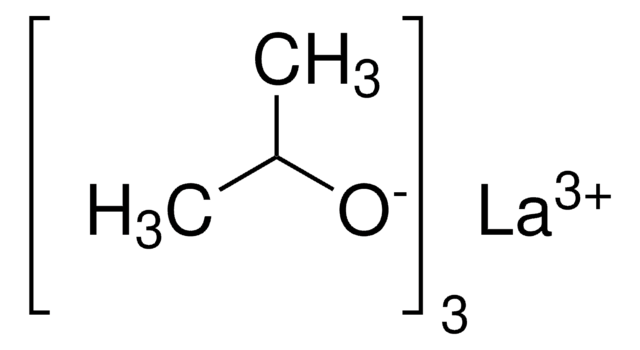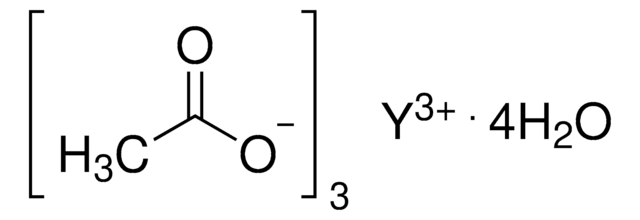510661
Yttrium(III) butoxide solution
0.5 M in toluene, ≥99.9% trace metals basis
Sign Into View Organizational & Contract Pricing
All Photos(2)
About This Item
Linear Formula:
Y(OC4H9)3
CAS Number:
Molecular Weight:
308.25
MDL number:
UNSPSC Code:
12352103
PubChem Substance ID:
NACRES:
NA.23
Recommended Products
Assay
≥99.9% trace metals basis
form
liquid
reaction suitability
core: yttrium
reagent type: catalyst
concentration
0.5 M in toluene
refractive index
n20/D 1.495
bp
109 °C
density
0.9 g/mL at 25 °C
SMILES string
CCCCO[Y](OCCCC)OCCCC
InChI
1S/3C4H9O.Y/c3*1-2-3-4-5;/h3*2-4H2,1H3;/q3*-1;+3
InChI key
PCOPFSXTYFFNIG-UHFFFAOYSA-N
General description
Yttrium(III) butoxide is an organometallic compound commonly utilized as a precursor in the synthesis of various yttrium-based compounds. These compounds are widely used in optical coatings, ceramics, electronic components, and superconducting materials.
Application
Precursor to composite film electrode for solid oxide fuel cells.
Yttrium(III) butoxide serves as a key precursor in:
- Sol–gel synthesis of barium zirconate-based perovskites BaZr0.8Y0.2O3−δ, used as an electrolyte in protonic ceramic fuel cells (PCFCs) and protonic ceramic electrolyzer cells (PCECs) and other electrochemical devices.
- Solvothermal synthesis of Y-doped SnO₂ nanocrystals (Y-SnO₂ NCs), which serve as an electron transport layer (ETL) in planar perovskite solar cells.
- Synthesis of yttrium doped BaTiO3 barium titanate widely used material for electric ceramics due to its excellent dielectric, ferroelectric, and piezoelectric properties.
- Synthesis of Y4Al2O9 nanoparticles utilized in various optoelectronic applications, including LED lighting, display technologies, and potentially in solar energy conversion systems.
Features and Benefits
- With a purity level of ≥99.9% (<1000ppm), it enhances the quality and reliability of applications in ceramics and thin films.
- Yttrium(III) butoxide with ≥99.9% purity improves the mechanical, thermal, and electrical properties of final materials, boosting their effectiveness and reliability.
Signal Word
Danger
Hazard Statements
Precautionary Statements
Hazard Classifications
Aquatic Chronic 3 - Asp. Tox. 1 - Eye Irrit. 2 - Flam. Liq. 2 - Repr. 2 - Skin Irrit. 2 - STOT RE 2 Inhalation - STOT SE 3
Target Organs
Central nervous system
Storage Class Code
3 - Flammable liquids
WGK
WGK 3
Flash Point(F)
46.4 °F - closed cup
Flash Point(C)
8 °C - closed cup
Choose from one of the most recent versions:
Already Own This Product?
Find documentation for the products that you have recently purchased in the Document Library.
Our team of scientists has experience in all areas of research including Life Science, Material Science, Chemical Synthesis, Chromatography, Analytical and many others.
Contact Technical Service
![Tris[N,N-bis(trimethylsilyl)amide]yttrium](/deepweb/assets/sigmaaldrich/product/structures/867/983/5b7cb7cd-8879-49e4-a9d7-29c52aaa82a0/640/5b7cb7cd-8879-49e4-a9d7-29c52aaa82a0.png)










